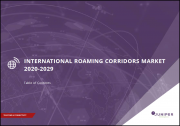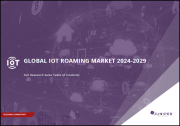
|
시장보고서
상품코드
1736916
세계의 로밍 요금 시장 규모 : 유형별, 유통 채널별, 서비스별, 지역별, 범위 및 예측Global Roaming Tariff Market Size By Type (Regional, National, International), By Distribution Channel (Retail Roaming, Wholesale Roaming), By Service (Data, SMS), By Geographic Scope And Forecast |
||||||
로밍 요금 시장 규모 및 예측
로밍 요금 시장 규모는 2024년 762억 2,000만 달러로 평가되었고, 2026-2032년 연평균 5.89% 성장하여 2032년에는 약 1,204억 8,000만 달러에 달할 것으로 예측됩니다.
주요 기업들은 결국 문제를 해결하고 산업을 안정화하기 위한 새로운 접근 방식과 기술을 찾았습니다. 이는 예측 기간 동안 상당한 시장 성장으로 이어질 것입니다. 세계 로밍 요금 시장 보고서는 시장의 전반적인 평가를 제공합니다. 주요 부문, 동향, 시장 성장 촉진요인, 억제요인, 경쟁 구도, 시장에서 중요한 역할을 하는 요인 등을 종합적으로 분석합니다.
세계 로밍 요금 시장의 정의
로밍이란 무선통신의 하나로, 휴대폰 이용자가 자동으로 음성통화 발신 및 수신, 데이터 송수신, 기타 서비스를 이용할 수 있는 기능을 말합니다. 로밍 요금은 무선 음성 서비스는 1분 단위, 문자 메시지는 1통 단위, 데이터 서비스는 1초당 1메가바이트 단위로 부과되는 요금을 말합니다. 지역별, 국내, 국제, 표준간 로밍, 모바일 시그니처 로밍, 기타로 분류됩니다.
요금 체계는 회사, 위치, 유형, 서비스 제공업체에 따라 다릅니다. 통신 산업, 전자제품, 스마트폰 용도 등 다양한 분야에서 활용되고 있습니다. 시장은 고도로 통합되어 있으며, 경쟁이 치열합니다. 각 업체들은 성장 전략으로 주로 M&A에 집중하고 있습니다.
세계 로밍 요금 시장 개요
세계 신흥 경제국에서의 4G 스마트폰 보급 확대와 5G 기술의 등장, 국제 관광 활동 증가, 인터넷 사용자 증가는 세계의 로밍 요금 시장의 성장을 가속할 것으로 예측됩니다. 또한, 더 넓은 네트워크 커버리지, 인구 증가, 국민 구매력 향상에 따른 LTE 가입 증가가 시장 성장을 가속할 것으로 예측됩니다.
또한, 세계 5G 서비스 출시는 예측 기간 동안 수요를 촉진할 것으로 예측됩니다. 그러나 네트워크 사업자의 요금 마진을 감소시키는 정부 규제가 전체 시장 성장을 저해하고 있습니다. 그럼에도 불구하고 스마트폰 및 통신 기술의 발전, 신제품 개발, 신흥국 시장의 미개척 잠재력은 긍정적인 성장 기회를 제공할 것입니다.
목차
제1장 세계의 로밍 요금 시장 서론
- 시장 개요
- 조사 범위
- 전제조건
제2장 주요 요약
제3장 VERIFIED MARKET RESEARCH의 조사 방법
- 데이터 마이닝
- 밸리데이션
- 1차 자료
- 데이터 소스 리스트
제4장 세계의 로밍 요금 시장 전망
- 개요
- 시장 역학
- 성장 촉진요인
- 성장 억제요인
- 기회
- Porter's Five Forces 모델
- 밸류체인 분석
제5장 세계의 로밍 요금 시장 : 유형별
- 개요
- 지역별
- 국내
- 국제
- 기타
제6장 세계의 로밍 요금 시장 : 유통 채널별
- 개요
- 소매 로밍
- 도매 로밍
제7장 세계의 로밍 요금 시장 : 서비스별
- 개요
- 데이터
- SMS
- 음성
제8장 세계의 로밍 요금 시장 : 지역별
- 개요
- 북미
- 미국
- 캐나다
- 멕시코
- 유럽
- 독일
- 영국
- 프랑스
- 이탈리아
- 스페인
- 기타 유럽
- 아시아태평양
- 중국
- 일본
- 인도
- 기타 아시아태평양
- 라틴아메리카
- 브라질
- 아르헨티나
- 기타 라틴아메리카
- 중동 및 아프리카
- 아랍에미리트(UAE)
- 사우디아라비아
- 남아프리카공화국
- 기타 중동 및 아프리카
제9장 세계의 로밍 요금 시장 경쟁 구도
- 개요
- 기업의 시장 순위
- 주요 발전 전략
제10장 기업 개요
- America Movil
- AT&T Inc.
- Bharti Airtel Ltd.
- China Mobile Ltd.
- Deutsche Telekom AG
- Digicel Group
- T-Mobile(Sprint Corporation)
- Telefonica SA
- Verizon Communications Inc.
- Vodafone Group plc
제11장 주요 발전
- 서비스 유형 출시/개발
- 인수합병(M&A)
- 사업 확대
- 파트너십과 제휴
제12장 부록
LSH 25.06.16Roaming Tariff Market Size And Forecast
Roaming Tariff Market size was valued at USD 76.22 Billion in 2024 and is projected to reach around USD 120.48 Billion by 2032, growing at a CAGR of 5.89% from 2026 to 2032.
Major corporations have ultimately found new approaches and technologies to address issues and stabilize the industry. This will lead to substantial market growth over the forecasted period. The Global Roaming Tariff Market report provides a holistic evaluation of the market. The report offers a comprehensive analysis of key segments, trends, drivers, restraints, competitive landscape, and factors that are playing a substantial role in the market.
Global Roaming Tariff Market Definition
Roaming is a wireless telecommunication refers to the ability for a cellular customer to automatically make and receive voice calls, send and receive data, or access other services. The roaming tariff means the fees charged on a per-minute basis for wireless voice service, per text message, and per megabyte per second for data service provided. It is categorized into regional, national, international, inter-standard roaming, mobile signature roaming, and others.
The tariff rates differ by company, location, type, and service provider. It finds extensive applications in the telecommunication industry, electronics, and smartphone applications. The market is highly consolidated and exemplified by high competition. The companies are majorly focusing on mergers and acquisitions as their growth strategies.
Global Roaming Tariff Market Overview
The growing adoption of 4g enabled increasing smartphones and the emergence of 5G technology across developed economies across the globe, the rise in international tourism activities, and the increasing number of internet users are expected to boost the growth of the Global Roaming Tariff Market. Moreover, an increase in the subscription of LTE owing to broader network coverage, growing population, and higher purchasing power of the public is anticipated to propel the market growth.
Furthermore, the launch of 5g services globally is likely to drive the demand for the forecast period. However, government regulations to reduce the tariff margins of network providers, is hampering the overall market growth. Nevertheless, the advancements in smartphones and communication technologies, new product development, and untapped potential in emerging markets offer favorable growth opportunities.
Global Roaming Tariff Market Segmentation Analysis
The Global Roaming Tariff Market is segmented on the basis of Type, Distribution Channel, Service, and Geography.
Roaming Tariff Market, By Type
- Regional
- National
- International
- Others
Based on Type, the market is bifurcated into Regional, National, International, and Others. Out of which the international roaming services segment will dominate the Global Roaming Tariff Market due to the growing international tourism and trade across the globe. The international Roaming Tariff Market will be further escalated considering the growing rates of international telecom tariffs. For instance; in the U.S., national and international roaming shares are growing owing to the presence of key players such as T-Mobile USA, Inc. and Verizon Communications, Inc. These key players must sign national roaming agreements to offer international roaming services globally.
Roaming Tariff Market, By Distribution Channel
- Retail Roaming
- Wholesale Roaming
Based on Distribution Channel, the market is bifurcated into Retail Roaming and Wholesale Roaming. Out of which, the Wholesale roaming segment dominates the Global Roaming Tariff Market during the forecast period as the companies started cutting down wholesale roaming charges, especially for the invasion of Ukraine in February 2022. This has enabled wider adoption of network services provided by such companies, which has paved the way for market growth in the coming years.
- The wholesale roaming is one of the highest processes due to technological advancement in the latest telecom services such as blockchain helps in improving network efficiency, and reducing roaming costs among others, contributing to the growth of the wholesale segment during the forecast period.
Roaming Tariff Market, By Service
- Data
- SMS
- Voice
Based on Service, the market is bifurcated into Data, SMS, and Voice. Out of which, the data roaming tariffs segment dominates the Global Roaming Tariff Market during the forecast period. This is due to the presence of a large number of companies that are offering data roaming services, across several countries. For instance, in April 2022, SWAN (Slovakian telecommunication operators) launched 5G roaming services across 7 European Union countries.
Roaming Tariff Market, By Geography
- North America
- Europe
- Asia Pacific
- Middle East and Africa
- Latin America
Based on Geography, The Global Roaming Tariff Market is classified into North America, Europe, Asia Pacific, Middle East and Africa, and Latin America. The Asia Pacific region dominates the Global Roaming Tariff Market owing to the growing demand for international trade and tourism across the regions. Also, a rise in the number of international tourists, cheaper roaming charges, and the presence of global companies among others is likely to propel the Global Roaming Tariff Market growth during the forecasted period. However, some underlying factors have pushed the growth of the Asia Pacific region in the market such as the expansion of network coverage by local telecommunication providers. Additionally, the Asia Pacific region is expected to witness significant growth due to rising demand from startups and import-export businesses across developing Asian economies such as India.
- These parent regions are further segmented as follows; Asia Pacific (China, India, Japan, Rest of APAC), Europe (Germany, UK, France, Spain, Italy, Rest of Europe), North America (US, Canada, Mexico), Latin America (Brazil, Argentina, Rest of LATAM), and Middle East & Africa (UAE, Saudi Arabia, South Africa, Rest of MEA).
Key Players
The "Global Roaming Tariff Market" study report will provide valuable insight with an emphasis on the global market. The major players in the market are America Movil, AT&T Inc., Bharti Airtel Ltd., China Mobile Ltd., Deutsche Telekom AG, Digicel Group Mobile (Sprint Corporation), Telefonica SA, Verizon Communications Inc., Vodafone Group plc, and Others.
Our market analysis also entails a section solely dedicated to such major players wherein our analysts provide an insight into the financial statements of all the major players, along with its Service Type benchmarking and SWOT analysis. The competitive landscape section also includes key development strategies, market share, and market ranking analysis of the above-mentioned players globally.
- Ace Matrix Analysis
- The Ace Matrix provided in the report would help to understand how the major key players involved in this industry are performing as we provide a ranking for these companies based on various factors such as service features & innovations, scalability, innovation of services, industry coverage, industry reach, and growth roadmap. Based on these factors, we rank the companies into four categories as Active, Cutting Edge, Emerging, and Innovators.
- Market Attractiveness
- The image of market attractiveness provided would further help to get information about the region that is majorly leading in the Global Roaming Tariff Market. We cover the major impacting factors that are responsible for driving the industry growth in the given region.
- Porter's Five Forces
- The image provided would further help to get information about Porter's five forces framework providing a blueprint for understanding the behavior of competitors and a player's strategic positioning in the respective industry. Porter's five forces model can be used to assess the competitive landscape in the Global Roaming Tariff Market, gauge the attractiveness of a certain sector, and assess investment possibilities.
TABLE OF CONTENTS
1 INTRODUCTION OF THE GLOBAL ROAMING TARIFF MARKET
- 1.1 Overview of the Market
- 1.2 Scope of Report
- 1.3 Assumptions
2 EXECUTIVE SUMMARY
3 RESEARCH METHODOLOGY OF VERIFIED MARKET RESEARCH
- 3.1 Data Mining
- 3.2 Validation
- 3.3 Primary Interviews
- 3.4 List of Data Sources
4 GLOBAL ROAMING TARIFF MARKET OUTLOOK
- 4.1 Overview
- 4.2 Market Dynamics
- 4.2.1 Drivers
- 4.2.2 Restraints
- 4.2.3 Opportunities
- 4.3 Porter's Five Force Model
- 4.4 Value Chain Analysis
5 GLOBAL ROAMING TARIFF MARKET, BY TYPE
- 5.1 Overview
- 5.2 Regional
- 5.3 National
- 5.4 International
- 5.5 Others
6 GLOBAL ROAMING TARIFF MARKET, BY DISTRIBUTION CHANNEL
- 6.1 Overview
- 6.2 Retail Roaming
- 6.3 Wholesale Roaming
7 GLOBAL ROAMING TARIFF MARKET, BY SERVICE
- 7.1 Overview
- 7.2 Data
- 7.3 SMS
- 7.4 Voice
8 GLOBAL ROAMING TARIFF MARKET, BY GEOGRAPHY
- 8.1 Overview
- 8.2 North America
- 8.2.1 The U.S.
- 8.2.2 Canada
- 8.2.3 Mexico
- 8.3 Europe
- 8.3.1 Germany
- 8.3.2 The U.K.
- 8.3.3 France
- 8.3.4 Italy
- 8.3.5 Spain
- 8.3.6 Rest of Europe
- 8.4 Asia Pacific
- 8.4.1 China
- 8.4.2 Japan
- 8.4.3 India
- 8.4.4 Rest of Asia Pacific
- 8.5 Latin America
- 8.5.1 Brazil
- 8.5.2 Argentina
- 8.5.3 Rest of LATAM
- 8.6 Middle East and Africa
- 8.6.1 UAE
- 8.6.2 Saudi Arabia
- 8.6.3 South Africa
- 8.6.4 Rest of the Middle East and Africa
9 GLOBAL ROAMING TARIFF MARKET COMPETITIVE LANDSCAPE
- 9.1 Overview
- 9.2 Company Market Ranking
- 9.3 Key Development Strategies
10 COMPANY PROFILES
- 10.1 America Movil
- 10.1.1 Company Overview
- 10.1.2 Company Insights
- 10.1.3 Business Breakdown
- 10.1.4 Product Benchmarking
- 10.1.5 Key Developments
- 10.1.6 Winning Imperatives
- 10.1.7 Current Focus & Strategies
- 10.1.8 Threat from Competition
- 10.1.9 SWOT Analysis
- 10.2 AT&T Inc.
- 10.2.1 Company Overview
- 10.2.2 Company Insights
- 10.2.3 Business Breakdown
- 10.2.4 Product Benchmarking
- 10.2.5 Key Developments
- 10.2.6 Winning Imperatives
- 10.2.7 Current Focus & Strategies
- 10.2.8 Threat from Competition
- 10.2.9 SWOT Analysis
- 10.3 Bharti Airtel Ltd.
- 10.3.1 Company Overview
- 10.3.2 Company Insights
- 10.3.3 Business Breakdown
- 10.3.4 Product Benchmarking
- 10.3.5 Key Developments
- 10.3.6 Winning Imperatives
- 10.3.7 Current Focus & Strategies
- 10.3.8 Threat from Competition
- 10.3.9 SWOT Analysis
- 10.4 China Mobile Ltd.
- 10.4.1 Company Overview
- 10.4.2 Company Insights
- 10.4.3 Business Breakdown
- 10.4.4 Product Benchmarking
- 10.4.5 Key Developments
- 10.4.6 Winning Imperatives
- 10.4.7 Current Focus & Strategies
- 10.4.8 Threat from Competition
- 10.4.9 SWOT Analysis
- 10.5 Deutsche Telekom AG
- 10.5.1 Company Overview
- 10.5.2 Company Insights
- 10.5.3 Business Breakdown
- 10.5.4 Product Benchmarking
- 10.5.5 Key Developments
- 10.5.6 Winning Imperatives
- 10.5.7 Current Focus & Strategies
- 10.5.8 Threat from Competition
- 10.5.9 SWOT Analysis
- 10.6 Digicel Group
- 10.6.1 Company Overview
- 10.6.2 Company Insights
- 10.6.3 Business Breakdown
- 10.6.4 Product Benchmarking
- 10.6.5 Key Developments
- 10.6.6 Winning Imperatives
- 10.6.7 Current Focus & Strategies
- 10.6.8 Threat from Competition
- 10.6.9 SWOT Analysis
- 10.7 T-Mobile (Sprint Corporation)
- 10.7.1 Company Overview
- 10.7.2 Company Insights
- 10.7.3 Business Breakdown
- 10.7.4 Product Benchmarking
- 10.7.5 Key Developments
- 10.7.6 Winning Imperatives
- 10.7.7 Current Focus & Strategies
- 10.7.8 Threat from Competition
- 10.7.9 SWOT Analysis
- 10.8 Telefonica SA
- 10.8.1 Company Overview
- 10.8.2 Company Insights
- 10.8.3 Business Breakdown
- 10.8.4 Product Benchmarking
- 10.8.5 Key Developments
- 10.8.6 Winning Imperatives
- 10.8.7 Current Focus & Strategies
- 10.8.8 Threat from Competition
- 10.8.9 SWOT Analysis
- 10.9 Verizon Communications Inc.
- 10.9.1 Company Overview
- 10.9.2 Company Insights
- 10.9.3 Business Breakdown
- 10.9.4 Product Benchmarking
- 10.9.5 Key Developments
- 10.9.6 Winning Imperatives
- 10.9.7 Current Focus & Strategies
- 10.9.8 Threat from Competition
- 10.9.9 SWOT Analysis
- 10.10 Vodafone Group plc
- 10.10.1 Company Overview
- 10.10.2 Company Insights
- 10.10.3 Business Breakdown
- 10.10.4 Product Benchmarking
- 10.10.5 Key Developments
- 10.10.6 Winning Imperatives
- 10.10.7 Current Focus & Strategies
- 10.10.8 Threat from Competition
- 10.10.9 SWOT Analysis
11 KEY DEVELOPMENTS
- 11.1 Service Type Launches/Developments
- 11.2 Mergers and Acquisitions
- 11.3 Business Expansions
- 11.4 Partnerships and Collaborations
12 Appendix
Related Research
















